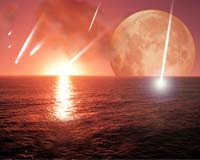(2) Geologists determined that the Earth’s atmosphere changed dramatically about two billion years ago. (2) They say at this time colossal deposits of red sandstone formed, the red color coming from the oxygen and the iron reacting to form iron oxide (rust). Geologists use this fact as evidence that Earth’s atmosphere contained at least some oxygen at this point (about one percent). The air was probably still not breathable though. (1) Scientists say the first oxygen was produced by organisms known as cyanobacteria through the process of photosynthesis.
(1) Today, the Earth’s atmosphere contains 78% nitrogen and 21% oxygen along with 1% other gases. Today’s oxygen in the atmosphere mainly originates from plants and small organisms like algae. As these oxygen-producing organisms increase in number, so does the oxygen in the atmosphere.
1.) “Origin of the Earth’s Atmosphere.” EIU.edu. 3 Apr. 2009.
2.) Dunbar, Brian. “Nasa-Earth.” 2007. Nasa.gov. 2 Apr. 2009.

